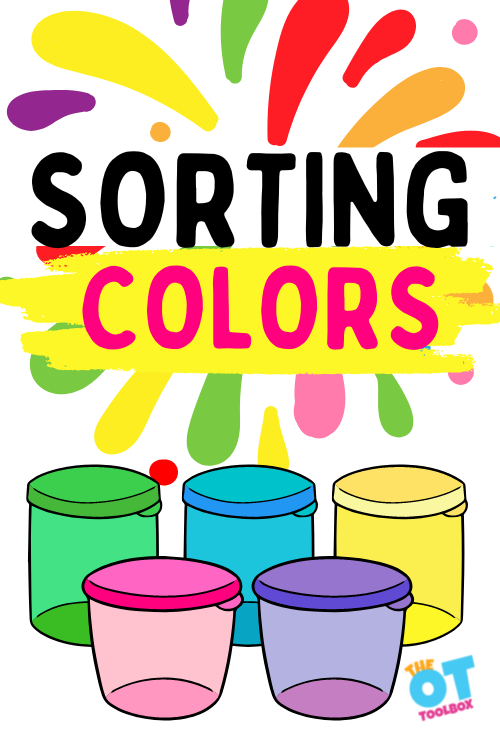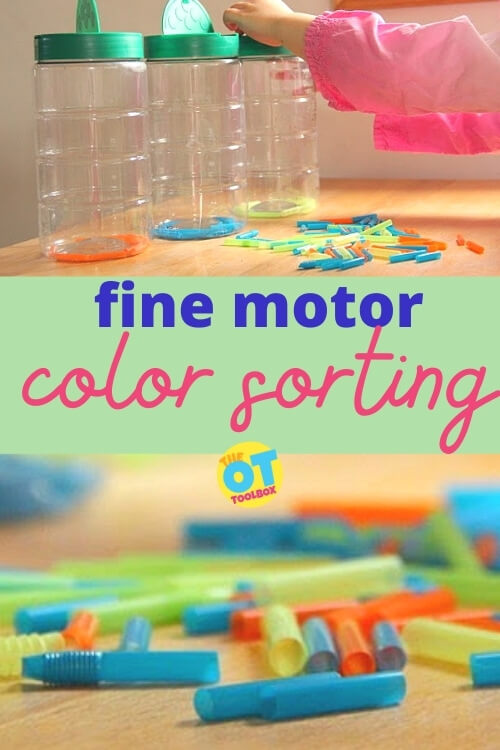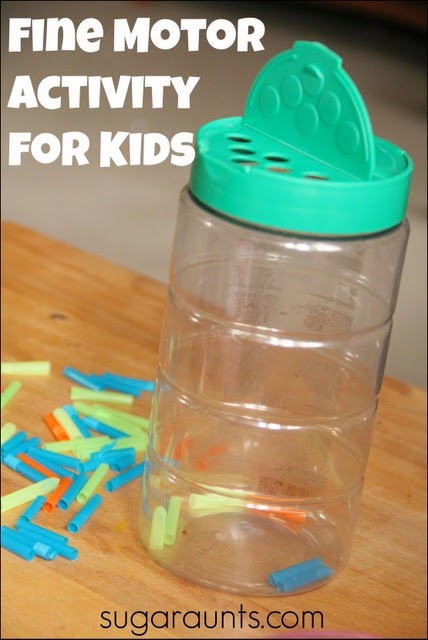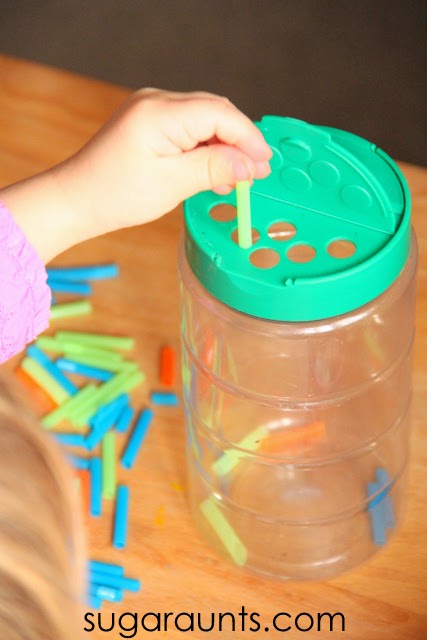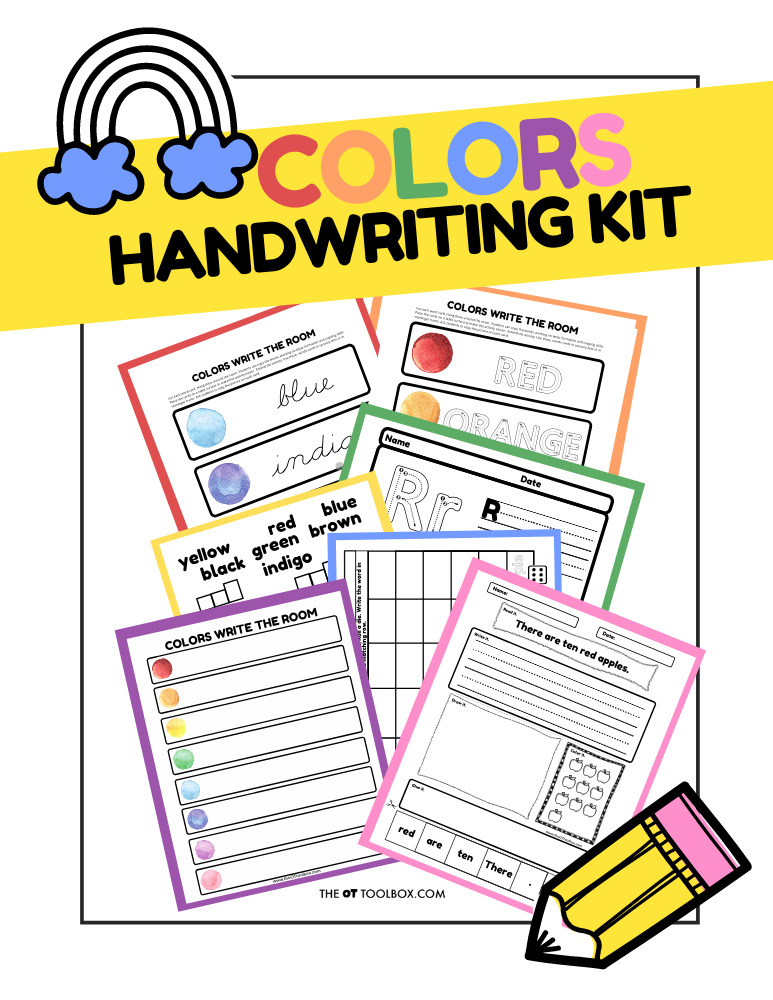Today we have a download that supports skills in kids (and adults) with these printable Valentine Cards. Use these printable activities along with some treats for a kid-made gift that helps them develop skills while making the cards. What parent or teacher wouldn’t love that type of holiday card! This PDF file is a winner when used to develop handwriting skills, coloring, visual motor skills, direction following, and more! Add this fun idea to your list of Valentine’s Day occupational therapy activities.
Also be sure to get our Valentines Day I Spy activity for more skill-building. You’ll also love our Conversation Heart Sort. It’s a sorting worksheet for a fine motor activity with conversation hearts.
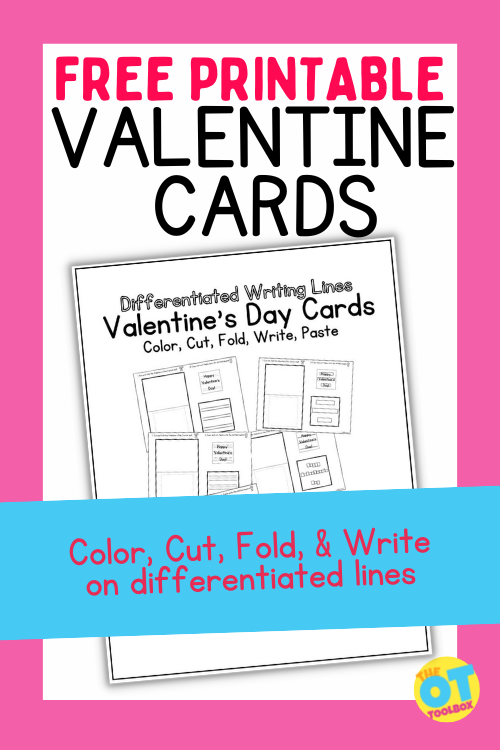
Printable Valentines Cards
Sometimes a fun activity can make skill-building better! That’s where these adorable cards come into play. Grab a copy of the printable valentines and add your own message for working on handwriting skills, empathy, and more. It’s a fun way to develop goal areas using the holiday fun!
Can you believe how big this holiday is? Billions of dollars are spent buying Valentine’s gifts for others, millions of cards are sent, and hours of time is spent preparing for the festivities. However shallow and costly this may seem, we could all use a reason to celebrate. Some months it seems we slog from one week to the next waiting for the weekends to arrive, only to do it all over again on Monday. An added day or week of excitement breaks up the monotony and gives us a reason to celebrate. These free Printable Valentines Cards are perfect for celebrating without breaking the bank!
Kids of all ages can use these printables in occupational therapy sessions, the classroom or the home.
FOLDABLE PRINTABLE VALENTINES DAY CARDS TO COLOR
If you are looking for the perfect classroom valentines, look no further.
Not everyone has the money or belief to spend lots of money every time a holiday comes around. Many recipients find a homemade card or gift to be much more meaningful than a store bought one.
Let your learners of all ages show their creativity with these free printable Valentine’s cards to color. Enter your email address below and your printable Valentine’s day cards will shoot directly into your inbox.
The free printables are a great tool to work on coloring skills with an end result, while still allowing the kiddo (or user of any age) to show creative expression.
Get out lots of different art supplies to help your learners use their creativity. Pens, markers, glue, glitter, sequins, dot markers, paint, crayons, ribbon, tissue paper, and anything that can be used to decorate the free printable Valentine’s card will be a win with your learners.
As an added benefit, using the foldable printable Valentines Day cards to color and develop fine motor skills, users can work on eye-hand coordination, pinch and grip strength, visual motor skills, and more.
As you walk down the hallways of different schools, you might see different types of art projects. What do you notice? Many of them are cookie cutter, with all of the pieces exactly where they belong, looking identical to one another.
While this is super cute to send home to parents, there are a lot of reasons to stop doing this.
- Young learners thrive on experimentation, getting messy, and free expression
- Parents have a better picture of their child’s abilities if they see what their child makes independently
- Learners get comfortable making mistakes while noticing their picture looks different than others
- What better way to learn cause and effect by dumping a bottle of glitter and heaps of glue onto their printable Valentine’s card?
- Teachers can witness their learner’s ability to independently follow a model without intervention, track their progress, and see their skills without influence.
- Caregivers can learn a lot about the sensory system by watching young learners create. The sensory seeker might put their hands in the paint and spread it up to their elbows. The avoider might pick crayons instead of messy markers. A seeker tends to mark heavily on the paper with vigorous strokes, while the avoider draws with lighter strokes.
- The ABC Learning Center has a great article on what artwork reveals about a person
An open-ended tool such as these thoughtful valentine’s day gift cards can support skill development while still allowing the user creative expression oppourtunites.
Free Printable Valentine Cards to Color
Start practicing today with the free printable Valentine cards to color. Make the decision to put out the supplies and let the students create their masterpiece independently. You can show an example so the students get an idea, however encourage learners not to just copy yours.
- Stop prioritizing product over process
- Sit on your hands if you need to. Sometimes the urge to “fix” things is overwhelming. Learners don’t always need reminders that they forgot to draw a nose, or that clouds are not pink.
- Limit the amount of directions you give
- Talk about their art. “I notice your whole picture is blue, what made you decide to choose that color?”
- Encourage experimentation. As ugly as we might think it might be, young learners think mixing all of the paints into the infamous gray blob is exciting
- Try not to criticize. Notice the process instead
There are times when the end product is supposed to look like the model in order to address following directions, however it does not have to look exactly like the model if the learner is unable to do this independently. You can discuss with the class your objectives for the task such as color inside the lines, cutting on the lines, and having legible handwriting.
This is not easy. There are some educators and therapists cringing as they read this. One teacher I work with only offers colored pencils because everything else is messy. Another freaks out if something goes awry. On the opposite end, I have teachers who embrace me coming in and letting their learners get messy and create how they are able. This week not one penguin looked like the other in the hallway outside one class!!
SKILLS LEARNED MAKING FOLDABLE FREE VALENTINE’S CARDS
As you set out the free printable Valentine’s day cards, get excited about how different each learner’s art will be. Watch as they make messes and get creative.
Younger children can simply decorate the printable cards. Older users, teens, or participants of any age can use the printable cards as last-minute valentine’s day cards that support handwriting and direction-following skills.
Take time to notice the great skills they are working on as they complete their printable Valentine’s cards:
- Folding paper
- Coloring inside the lines
- Sensory exploration – drippy glue, sequins, glitter, finger paints, paper shreds
- finger/hand strength
- Cutting along lines
- Using glue to paste images onto the cards
- Writing on differentiated lines
- Handwriting for writing name, letters, etc.
- Bilateral coordination
- Executive function, following directions, attention, attention to detail, focus, sequencing, planning, task completion, neatness, impulse control, compliance, behavior, and work tolerance to name a few
- Social function – working together in a group, problem solving, sharing materials and space, turn taking, talking about their work, making mistakes
These printable Valentine Cards would look great on an occupational therapy bulletin board or sent to special teachers or paraprofessional support individuals in the school, too. This is a thoughtful Valentine’s Day gift that “gives” in more ways than one!
A general search on the OT Toolbox brought up dozens of posts and resources for Valentine’s day including hole punch cards, fine motor worksheets, fine motor printables, Valentine’s busy bag, Valentine sensory bottle, Valentines sensory bin, and more.
Enjoy the Valentine’s day celebration, however you choose to share it with others. Make time for creativity, and of course eating chocolate!
Free Printable Valentine Cards
Want to add this activity to your printable therapy resources? Enter your email address into the form below to access this therapy tool. This printable PDF is also available inside the Member’s Club. Members can log in and access the printable cards on our Valentine’s Day Therapy Theme (Level 2) or under Fine Motor Activities (Level 1 and 2).

Victoria Wood, OTR/L is a contributor to The OT Toolbox and has been providing Occupational Therapy treatment in pediatrics for more than 25 years. She has practiced in hospital settings (inpatient, outpatient, NICU, PICU), school systems, and outpatient clinics in several states. She has treated hundreds of children with various sensory processing dysfunction in the areas of behavior, gross/fine motor skills, social skills and self-care. Ms. Wood has also been a featured speaker at seminars, webinars, and school staff development training. She is the author of Seeing your Home and Community with Sensory Eyes.


